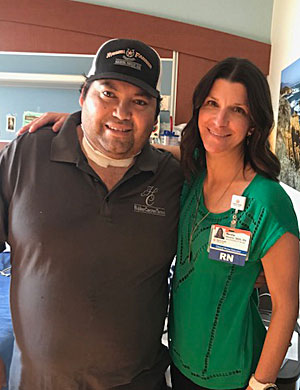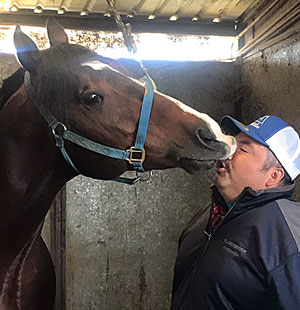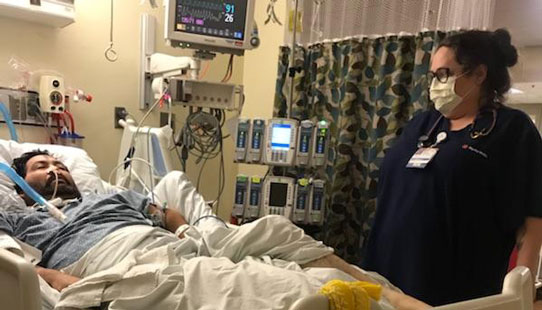
Patient Story - Armando Garcia Arvizo
Fighting for Every Breath
Dominican Hospital’s extracorporeal life support technology serves as an artificial lung for a critically ill patient
 Armando Garcia Arvizo, a 40-year-old living in Castroville, woke up with a fever on a Monday. By Thursday, he was forced to tell his boss he couldn’t come into work. By Saturday, he couldn’t get out of bed, and by Sunday, he told his wife, Alejandra Pragoso, that he couldn’t breathe and needed to get to a hospital right away.
Armando Garcia Arvizo, a 40-year-old living in Castroville, woke up with a fever on a Monday. By Thursday, he was forced to tell his boss he couldn’t come into work. By Saturday, he couldn’t get out of bed, and by Sunday, he told his wife, Alejandra Pragoso, that he couldn’t breathe and needed to get to a hospital right away.
That simple flu turned out to be the H1N1 virus (swine flu), a particularly virulent strain of influenza which in 2009 infected and, in some cases, killed so great a number of people across the globe that the World Health Organization declared it a pandemic.
After being admitted to a nearby hospital, the doctors there found that the H1N1 virus had severely compromised Armando’s lungs. Though he continued to receive treatment, his condition was deteriorating so rapidly that his wife was told to gather the family for goodbyes.
“The doctors told me the only thing that could possibly help Armando was a technology called extracorporeal life support (ECLS),” says Alejandra. “They knew that Dominican Hospital offered this technology, but were worried Armando might not survive the trip—even if he was taken by a helicopter.”
Alejandra persisted, and Armando was transported to Dominican, where he was immediately put into a medically induced coma and placed on their ECLS machine.
 The ECLS system uses a man-made heart and lung to support the body when a person’s own organs are too sick to do the job. ECLS may support a patient for just hours, or for days and even weeks, allowing the heart and/or lungs the necessary time to rest and recover, and for the body to heal. ECLS is typically only used after a patient’s care team has tried all other treatments, such as a breathing machine (ventilator), medicines to support the heart and lungs, and/or special gases to relax the blood vessels between the heart and the lungs. Dominican is the only hospital in the Monterey bay area to provide ECLS technology, which was funded by community donations to the Dominican Hospital Foundation.
The ECLS system uses a man-made heart and lung to support the body when a person’s own organs are too sick to do the job. ECLS may support a patient for just hours, or for days and even weeks, allowing the heart and/or lungs the necessary time to rest and recover, and for the body to heal. ECLS is typically only used after a patient’s care team has tried all other treatments, such as a breathing machine (ventilator), medicines to support the heart and lungs, and/or special gases to relax the blood vessels between the heart and the lungs. Dominican is the only hospital in the Monterey bay area to provide ECLS technology, which was funded by community donations to the Dominican Hospital Foundation.
When Armando awoke 21 days later, he had no idea where he was and became panicked.
“I was alive but weak, and the transition off of ECLS was scary,” remembers Armando. “The doctors and nurses were so nice. Everyone treated us like family. They helped me to get off of the machine and to finally sit up in bed.”
Though walking was slow-going at first, each day got a little easier. With the support of his loved ones, and the doctors, nurses, and rehabilitation therapists at Dominican, Armando regained full mobility and was discharged after a little over two weeks.
“Every single day I was thankful to all the doctors, nurses, and therapists. They are why I’m alive,” says Armando. “The people at Dominican worked so hard for me. They were my angels.”
Cardiothoracic Surgeon and Dominican Hospital’s Medical Director of the Extracorporeal Life Support Program, Bilal Shafi, MD, and Dominican’s Clinical Educator of Cardiovascular Services and Extracorporeal Life Support Coordinator, Marsha Moreno, MSN, RN, made particularly strong impressions on Armando and Alejandra, and the feelings were mutual.
“It can be a desperate feeling to run out of options for patients,” explains Dr. Shafi. “Knowing that we have the opportunity to accept specific patients from other local medical facilities and utilize ECLS technology speaks to the innovation of our comprehensive cardiac surgery service program. More importantly, it allows us to give renewed hope to a patient’s loved ones.”
 “We have a highly dedicated team who truly cares about these patients,” says Ms. Moreno. “Given how serious the condition of ECLS patients, we often get to know the families before we get to know the patient. The love and devotion Alejandra and their sons feel for Armando was evident from the minute he arrived at Dominican. When he regained consciousness, the bond that had developed between our staff and his loved ones over those three weeks made his recovery that much more special. It was such an honor to take care of this family.”
“We have a highly dedicated team who truly cares about these patients,” says Ms. Moreno. “Given how serious the condition of ECLS patients, we often get to know the families before we get to know the patient. The love and devotion Alejandra and their sons feel for Armando was evident from the minute he arrived at Dominican. When he regained consciousness, the bond that had developed between our staff and his loved ones over those three weeks made his recovery that much more special. It was such an honor to take care of this family.”
Armando went home in early February of this year and, with help from the Dominican Hospital Home Health nursing team and his family, quickly recovered.
Today, his breathing is almost completely back to normal, and he has made important lifestyle changes—such as eating more healthfully and drinking more water. He can walk up and down the hills near his home and is back to riding his beloved horses again.
“This was a life-changing event for me,” says Armando. “I want to take better care of myself. I appreciate my life so much more now.”
For those in similar situations, Alejandra has this advice: “Don’t ever lose hope until you hear the last breath. Fight!”
